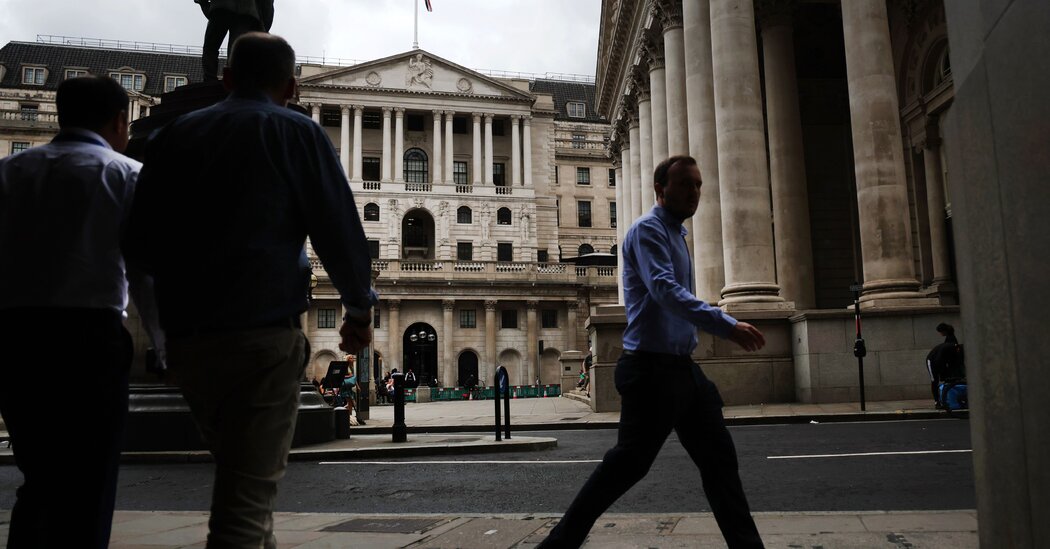What the Fed’s Rate Moves Could Mean for Mortgages, Credit Cards and More
While the Federal Reserve is expected to keep its key interest rate unchanged on Wednesday, American households will want to know whether rate cuts are on the horizon, which could have meaningful implications for their monthly budgets.
The central bank has already raised its benchmark rate to 5.25 to 5.50 percent, the highest level in more than two decades, in a series of increases over the past two years. The goal was to rein in inflation, which has cooled considerably. Fed officials have kept rates steady since July as they continue to monitor the economy.
It has remained robust, which means policymakers might take their time before pivoting to rate cuts. But some banks have already started reducing the rates they pay to consumers, including on some certificates of deposit.
Here’s how different rates are affected by the Fed’s decisions — and where they stand.
Credit Cards
Credit card rates are closely linked to the central bank’s actions, which means that consumers with revolving debt have seen those rates quickly rise over the past couple of years. (Increases usually occur within one or two billing cycles.) But don’t expect them to fall quite as rapidly.
“The urgency to pay down high-cost credit card or other debt is not diminished,” said Greg McBride, chief financial analyst at Bankrate.com. “Interest rates took the elevator going up, but they’re going to take the stairs coming down.”
That means that consumers should prioritize repayment of higher-cost debt and take advantage of zero-percent and low-rate balance transfer offers when they can.
The average rate on credit cards with assessed interest was 22.75 percent at the end of 2023, according to the Federal Reserve, compared with 20.40 percent in 2022 and 16.17 percent at the end of March 2022, when the Fed began its series of rate increases.
Car Loans
Auto loan rates remain elevated, which, coupled with higher car prices, continues to squeeze affordability. But that hasn’t deterred buyers, many of whom have come back to the market after putting off purchases for several years because of inventories that had been constrained during the Covid-19 pandemic and later by Russia’s invasion of Ukraine.
The market will most likely normalize this year: New vehicle inventory is expected to increase, which may help ease pricing and lead to better deals.
“Hints from the Fed that they’ve achieved their rate-hiking goals could be a sign that rates may be lowered at some point in 2024,” said Joseph Yoon, a consumer insights analyst at Edmunds, an automotive research firm. “Inventory improvements for manufacturers mean that shoppers will have more selection, and dealers will have to earn their customers’ business, potentially with stronger discounts and incentives.”
The average rate on new car loans was 7.1 percent in December 2023, according to Edmunds, up from 6.7 percent in December 2022. Used car rates were even higher: The average loan carried an 11.4 percent rate in December 2023, up from 10.3 percent in the same month of 2022.
Car loans tend to track with the five-year Treasury note, which is influenced by the Fed’s key rate — but that’s not the only factor that determines how much you’ll pay. A borrower’s credit history, the type of vehicle, the loan term and the down payment are all baked into that rate calculation.
Mortgages
Mortgage rates were volatile in 2023, with the average rate on a 30-year fixed loan climbing as high as 7.79 percent in late October before dropping about a point lower and stabilizing: The average rate on a 30-year mortgage was 6.69 percent as of Jan. 25, according to Freddie Mac, compared with 6.60 percent for an identical loan in the same week last year.
Rates on 30-year-fixed-rate mortgages don’t move in tandem with the Fed’s benchmark, but instead generally track with the yield on 10-year Treasury bonds, which are influenced by a variety of factors, including expectations about inflation, the Fed’s actions and how investors react.
Other home loans are more closely tethered to the central bank’s decisions. Home-equity lines of credit and adjustable-rate mortgages — which each carry variable interest rates — generally rise within two billing cycles after a change in the Fed’s rates. The average rate on a home-equity loan was 8.91 percent as of Jan. 24, according to Bankrate.com, while the average home-equity line of credit was 9.18 percent.
Student Loans
Borrowers who hold federal student loans are not affected by the Fed’s actions because such debt carries a fixed rate set by the government.
But batches of new federal student loans are priced each July based on the 10-year Treasury bond auction in May. And those loan rates have climbed: Borrowers with federal undergraduate loans disbursed after July 1, 2023 (and before July 1, 2024) will pay 5.5 percent, up from 4.99 percent for loans disbursed in the same period a year before. Just three years ago, rates were below 3 percent.
Graduate students taking out federal loans will also pay about half a point more than the rate from a year earlier, or about 7.05 percent on average, as will parents, at 8.05 percent on average.
Borrowers of private student loans have already seen rates climb because of previous rate increases: Both fixed- and variable-rate loans are linked to benchmarks that track the federal funds rate.
Savings Vehicles
With the Fed’s benchmark rate unchanged, savings account rates are expected to remain relatively steady. (A higher Fed rate often means that banks will pay more interest on their deposits, but that doesn’t always happen right away. They tend to pay more when they want to bring in more money.)
But now that rates might have peaked and could eventually drift lower, some online banks have already begun to lower rates on certificates of deposit, or C.D.s, which tend to track with similarly dated Treasury securities. Earlier this month, for example, the online banks Ally, Discover and Synchrony all reduced rates on their 12-month C.D.s to 5 percent from 5.15 to 5.30 percent. Marcus now pays 5.25 percent, down from 5.50 percent.
“It is a good time to lock into C.D.s.,” said Ken Tumin, founder of DepositAccounts.com, part of LendingTree. “C.D. rates are already falling, and as we move closer to the first rate cut, they will only go down more.”
The average one-year C.D. at online banks was 5.35 percent as of Jan. 1, up from 4.37 percent a year earlier, according to DepositAccounts.com.
The average yield on an online savings account was 4.49 percent as of Jan. 1, according to DepositAccounts.com, up from 3.31 percent a year ago. But yields on money-market funds offered by brokerage firms are even more alluring because they have tracked the federal funds rate more closely. The yield on the Crane 100 Money Fund Index, which tracks the largest money-market funds, was 5.17 percent on Jan.30.


